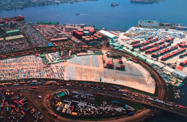Nigeria’s efforts towards improving the safety of its aviation sector, in the wake of a disastrous 2005 and 2006, have finally begun to pay dividends, as international recognition of the regulatory upgrades paves the way for greater efficiency and an improved business climate for the country’s domestic airlines. However, a concomitant proliferation of fees and charges has sparked an outcry from carriers who are continuing to grapple with an extremely competitive marketplace.
Improvements to safety priorities helped the country achieve Category 1 Status in August 2010, meaning that the industry meets the standards of the US Federal Aviation Authority’s international aviation safety assessment. This was a coup for both the sector and the wider economy as it enables airlines to open flight routes to the US with Nigerian-registered aircraft. As well as facilitating direct passenger travel between the two countries, this also opens up new routes for cargo shipments, which supports a range of industries in the country. Additionally, Category 1 countries typically enjoy some of the lowest insurance premiums in the sector, which could save airlines significant money in a market of tight margins. With this goal achieved, the government now wants to focus on the development of the country’s domestic airline industry.
In April 2011 the government announced the launch of an N50m ($335,000) aircraft tracking system, which analysts suggest will significantly improve air safety throughout the country. Set to be operated by the Nigerian Civil Aviation Authority (NCAA), the tracking system will help the NCAA monitor all aircraft flying in Nigerian airspace, an important step toward maintaining Category 1 status. In addition, the NCAA commissioned a Flight Tracking Operations Command Centre in April to help manage the anticipated increases in air traffic over the country.
Nigeria’s air safety record has seen impressive and much needed improvements in recent years. A spate of crashes in 2005-06, including one in Port Harcourt that claimed the lives of 60 schoolchildren, caused a public outcry and increased pressure to improve safety systems. The introduction of very high frequency (VHF) radio coverage across the board, a new radar facility and upgraded airside safety equipment were just some of the measures put into place to avoid further accidents.
Safety improvements aside, the sector remains hampered by dated infrastructure, an issue compounded by rising passenger volumes. Annual passenger traffic has increased steadily in recent years, rising 28.8% from 8.4m in 2007 to 10.82m in 2008, before jumping another 20% year-on-year to 12.53m in 2009. However, only a few of the country’s 22 airports have seen investments to their infrastructure in this time. The addition of a new domestic terminal Nigeria’s largest airport, Murtala Muhammed International Airport in Lagos, has not been enough to compensate for deficiencies elsewhere.
For the country’s airline operators, a number of additional obstacles must be overcome in order to fully capitalise on the growing demand for regional and domestic routes. Airport and navigational charges, for example, have emerged as a major point of contention in recent months, with domestic carriers complaining that the tariff structure is punitive. Charges incurred by airlines include ticket service charges, navigational fees, and landing and parking costs.
In March officials from two global aviation bodies, the International Civil Aviation Organisation (ICAO) and the International Air Transport Association (IATA) said that multiple levies could prevent airline profitability on the continent. “IATA and ICAO will take the lead in looking at proliferation of charges at airports without commensurable efforts, while states should also refrain from proliferation of taxes and charges that affect the airlines," Mike Higgins, the IATA regional vice-president for Africa, told local media. Following this, in early April, a number of Nigerian airlines announced their decisions to withhold landing and parking charges to the tune of N2bn ($13.4m) after a dispute over the role of a concessionaire responsible for fee collection.
Nigeria’s domestic airlines struggle to compete in an increasingly international arena, with actors warning that multi-designation of foreign carriers flying into Nigeria will hurt domestic airlines. “In the near future, we may see foreign carriers serving Lagos-Abuja and Lagos-Port Harcourt routes,” said Chris Ndulue, managing director of Arik Air Nigeria. This has led some in the sector to push for the National Assembly to pass a “Fly Nigeria Act”, which will compel officials to use domestic carriers for their overseas travel.
Last year, the government approved an N300bn ($2bn) bailout for the power and aviation sectors, 60% of which was earmarked for struggling domestic carriers. However, according to the National Association of Aircraft Pilots and Engineers (NAAPE), no Nigerian airline has yet been able to draw from this fund.
“Because the majority of our airlines have no money to acquire new aircraft, the local industry is forced to open its doors to more and more foreign-registered aircraft, which cannot provide employment for Nigerian pilots and aircraft engineers,” Isaac Balami, the NAAPE president, told local press.
Nigeria’s advances in aviation safety are to be applauded, but work to ensure the standards are maintained is an ongoing process. In the meantime, the authorities are still working out how to prioritise the needs of domestic airlines to ensure their competitiveness. They may need to work faster if the sector is to enjoy the high level of development on the horizon.

